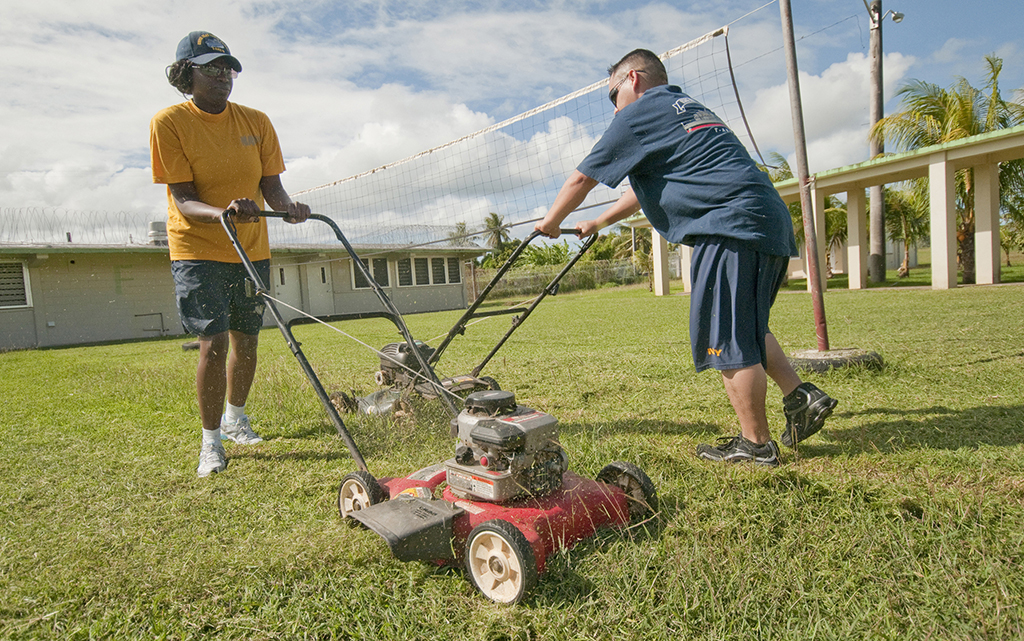
A new study found that gas-powered lawn equipment, like lawnmowers and leaf blowers, added hundreds of thousands of tons of pollutants to Arizona’s air in 2020, and called for a shift to electric gear. In this 2009 photo, sailors volunteer to mow the lawn at the Guam Department of Youth Affairs. (Photo by Petty Officer 2nd Class Corwin Colbert/U.S. Navy)
WASHINGTON – Gas-powered lawn equipment in Arizona emitted 445,908 tons of carbon dioxide in 2020, the polluting equivalent of putting 98,162 cars on the road, a new report says.
The report Monday by the Arizona Public Interest Research Group (PIRG) Education Fund also said gas-powered lawn mowers, blowers and trimmers contributed 985 tons of nitrogen oxides and 333 tons of fine particulate matter to the air that year, the most recent for which numbers are available.
“Gasoline-powered lawn equipment produces really shocking amount of air pollution right in the neighborhoods where we live and breathe,” said Tony Dutzik, associate director and senior policy analyst at the Frontier Group, who co-authored the report.
“These are pollutants like particulate matter and, you know, pollutants that lead to the formation of ozone smog that we know in some cases are linked to cancer, asthma attacks, other health problems,” Dutzik said.
Replacing gas-powered lawn and garden equipment with electric versions is one possible solution, the report said, either by encouraging private individuals to make the switch or by having local governments lead the way.
The first strategy is being pursued in Maricopa and Pima counties, where residents can receive cash vouchers for new electric equipment when they trade in their old gas-powered gear.
Diane E. Brown, the executive director of the Arizona PIRG Education Fund, said the programs “help consumers switch to electric equipment that is better for their pocketbooks, air quality and public health.”
“The largest barrier that consumers typically face in purchasing electric lawn equipment is the initial price tag. However, within one to three years that can be alleviated due to lower fuel and maintenance costs,” Brown said Monday.
The programs offer a $150 voucher toward the purchase of a zero-emission mower for those who trade in their gas-powered models, and a $50 voucher for electric equipment for those who turn in other items.
Natalie Shepp, the environmental planning manager for the Pima County Department of Environmental Quality, said her county’s Cut Down Pollution program began in early 2020. Since it began, more than 1,130 pieces of gas-powered equipment have been exchanged for vouchers.
“I do believe it has been successful,” Shepp said. “When we look at the air pollution contribution to those pieces of equipment now that they’re off the streets and recycled and being replaced with battery power, manual or plug-in electric (equipment). I do think it has had an impact and it is a beneficial program.”
The report said Pima County lawn equipment was responsible for 115,724 tons of carbon dioxide in 2020, the 45th highest among counties, along with 271 tons of nitrogen oxide and 95 tons of fine particulate matter.
Gas-powered equipment in Maricopa County added 233,413 tons of carbon dioxide, the 13th-highest county in the country. They also contributed 498 tons of nitrogen oxide and 167 tons of fine particulate matter to the air, the report said.
Both the Maricopa County and Pima County programs are funded by the Arizona Department of Environmental Quality.
Dutzik said programs like those “help speed this transition toward cleaner equipment.” He said it’s important to provide financial incentives for communities, but that cities could lead by example when “making that change themselves.”
“Ultimately, you know, the financial incentives are a really great way for people who are considering making the switch to get introduced to it and to make it more common in our communities,” Dutzik said. “There’s room here for … both incentives and for communities to really begin to explore transitioning away from this equipment.”

